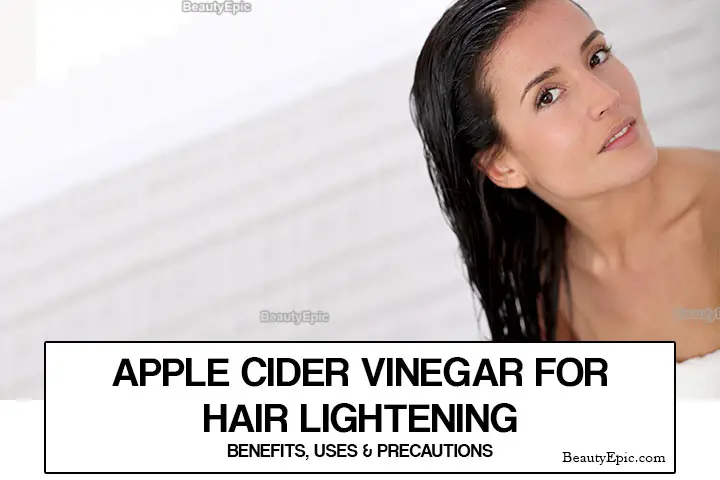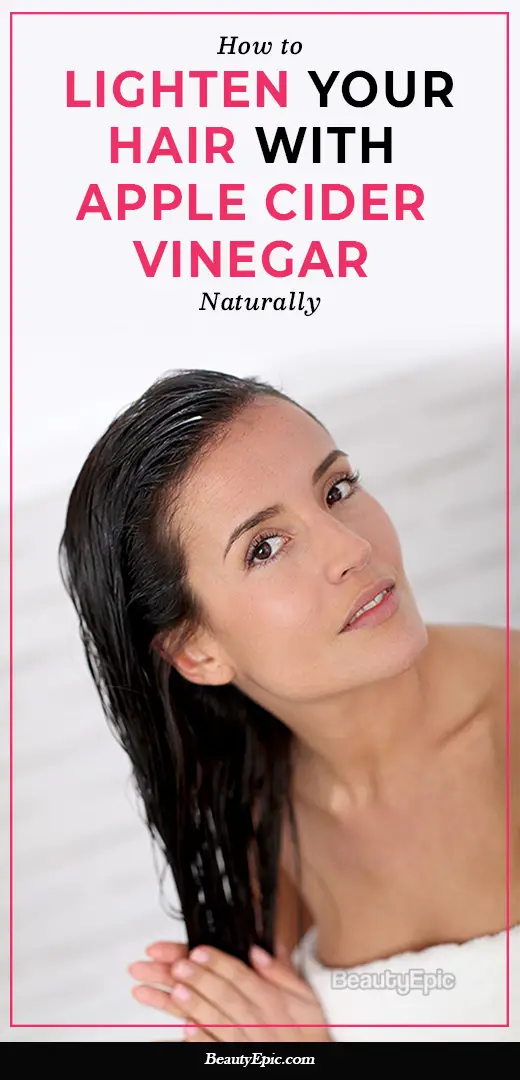
Important: This article is for informational purposes only. Please read our full disclaimer for more details.
Apple cider vinegar is often used as a homemade hair care solution. People use it as a natural conditioner that can effectively improve the quality of hair. It can also add more shine and luster to your hair.
Can Apple Cider Vinegar Make Your Hair Lighter?
Apple cider vinegar can be used in moderate quantities to lighten the hair naturally. However, the method is useful for those who require a gentle lightening.(1)
[ Read: How to Lighten Hair Naturally at Home ]
How to Lighten Hair with Apple Cider Vinegar?
Listed below are 3 effective ways to use apple cider vinegar to lighten your hair.
1. Apple Cider Vinegar and Honey
Things Required:
- Apple cider vinegar,
- Honey, and
- Water
How to do:
- Honey is a great nourishing agent for skin and hair. You can substantially add to the hair-lightening properties of apple cider vinegar by mixing it with honey.
- You can prepare a mixture by adding 3 tablespoons of apple cider vinegar with 3 tablespoons of honey.
- Add 50 ml of water to this mixture and apply evenly on your hair.
- If you want to lighten only a few strands, then use a cotton ball to apply the mixture. Rinse after 5 minutes and wash the hair thoroughly.
Best Time to Apply: Any time of the day.
No of Repetitions: Repeat the process 2 to 3 times a week.
[ Read: Honey Hair Lightening ]
2. Apple Cider Vinegar and Lemon Juice
Things Required:
- Apple cider vinegar,
- Lemon, and
- Water
How to do:
- Lemon is often used as a natural alternative for hair lightening products. However, it is safer to use lemon in combination with other natural agents to derive the best results.
- To lighten your hair naturally, you can prepare a mixture of 3 tablespoons of apple cider vinegar with 1 teaspoon of freshly squeezed lemon juice.
- Add 50 ml of water to this mixture and apply on the entire hair or on a few strands.
- Wait for 5 to 10 minutes before washing your hair with a moisturizing shampoo.
Best Time to Apply: Morning or afternoon.
No of Repetitions: Repeat the process once in a week.
3. Baking Soda And Apple Cider Vinegar
Things Required:
- Apple cider vinegar,
- Baking soda, and
- Water
How to do:
- If you want to lighten your hair by several shades, you can mix apple cider vinegar with baking soda.
- To get this done, add a teaspoon of baking soda to 3 tablespoons of apple cider vinegar mixed with 100 ml of water.
- If you have very dark hair, use only half a teaspoon of baking soda. You can spray the mixture on your hair or apply with a brush.
- Let the hair absorb the mixture for 5 minutes and then rinse thoroughly with a mild shampoo.
- You can try it anytime during the day. Frequent use of baking soda is not recommended.
- Still, you can practice the process once in a week if required.
Best Time to Apply: Any time of the day.
No of Repetitions: Repeat the process once in a week.
[ Read: Does Baking Soda Lighten Hair ]
Precautions and Tips
Although apple cider vinegar is a popular home remedy for a wide range of health issues, you should try it in milder doses if you are using it for the first time. Make sure that you use filtered apple cider vinegar for preparing the mixture. Also, if you have a sensitive hair or scalp you can replace baking soda with yogurt.
You Might Also Like:
- 15 Best Hairstyles For Transitioning Hair
- Best Purple Hair Dye For Dark Hair
- How To Keep Purple Hair from Fading
- How To Do Drag Makeup
- Why Should You Go For Antifungal Shampoo
- How to Lighten Your Hair With Cinnamon
- How to Use Chamomile Tea to Lighten Hair
- tgin Moisturizing Shampoo & Conditioner Review
- 2 Best Homemade Hair Lightening Spray With Lemon
















